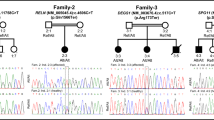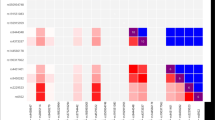Abstract
Objective
Gliomas are the most common tumors in the central nervous system. The cancer susceptibility candidate 15 (CASC15) gene has been reported to be a susceptibility gene for several types of cancer. No studies have been carried out on the predisposing effect of CASC15 gene single nucleotide polymorphisms (SNPs) on glioma risk.
Methods
In order to determine whether CASC15 gene SNPs are involved in glioma susceptibility, the first association study in a relatively large sample, which consisted of 171 patients and 228 healthy controls recruited from China, was performed. The contribution of SNPs (rs6939340 A>G, rs4712653 T>C and rs9295536 C>A) to the risk of glioma was evaluated by multinomial logistic regression, based on the calculation of the odds ratio (OR) and 95% confidence interval (CI).
Results
In the single locus and combined analysis, it was revealed that the genetic risk score had no significant associations between CASC15 gene SNPs and glioma risk. However, in the stratified analysis, a significant decrease in risk of glioma was observed in subjects of <60 months old with the rs4712653 TT genotype, when compared to those with the CC/CT genotype (OR=0.12, 95% CI=0.02–0.91, P=0.041).
Conclusion
The present study provides referential evidence on the association between the genetic predisposition of the CASC15 gene and glioma risk in Chinese children. However, more well-designed case-control studies and functional experiments are needed to further explore the role of CASC15 gene SNPs.
Similar content being viewed by others
References
Ostrom QT, Gittleman H, Liao P, et al. Cbtrus statistical report: Primary brain and central nervous system tumors diagnosed in the united states in 2007–2011. Neuro Oncol, 2014,16 Suppl 4:iv1–63
Neglia JP, Robison LL, Stovall M, et al. New primary neoplasms of the central nervous system in survivors of childhood cancer: A report from the childhood cancer survivor study. J Natl Cancer Inst, 2006,98(21):1528–1537
Feng RM, Zong YN, Cao SM, et al. Current cancer situation in china: Good or bad news from the 2018 global cancer statistics? Cancer Commun (Lond), 2019,39(1):22
Weller M, Wick W, Aldape K, et al. Glioma. Nat Rev Dis Primers, 2015,1:15017
Udaka YT, Packer RJ. Pediatric brain tumors. Neurol Clin, 2018,36(3):533–556
Louis DN, Perry A, Reifenberger G, et al. The 2016 world health organization classification of tumors of the central nervous system: A summary. Acta Neuropathol, 2016,131(6):803–820
Bush NA, Chang SM, Berger MS. Current and future strategies for treatment of glioma. Neurosurg Rev, 2017,40(1):1–14
Bondy ML, Scheurer ME, Malmer B, et al. Brain tumor epidemiology: Consensus from the brain tumor epidemiology consortium. Cancer, 2008,113(7 Suppl):1953–1968
Vienne-Jumeau A, Tafani C, Ricard D. Environmental risk factors of primary brain tumors: A review. Rev Neurol (Paris), 2019,175(10):664–678
Davis ME. Epidemiology and overview of gliomas. Semin Oncol Nurs, 2018,34(5):420–429
Wrensch M, Jenkins RB, Chang JS, et al. Variants in the cdkn2b and rtel1 regions are associated with high-grade glioma susceptibility. Nat Genet, 2009,41(8):905–908
Shete S, Hosking FJ, Robertson LB, et al. Genome-wide association study identifies five susceptibility loci for glioma. Nat Genet, 2009,41(8):899–904
Melin BS, Barnholtz-Sloan JS, Wrensch MR, et al. Genome-wide association study of glioma subtypes identifies specific differences in genetic susceptibility to glioblastoma and non-glioblastoma tumors. Nat Genet, 2017,49(5):789–794
Kinnersley B, Labussiere M, Holroyd A, et al. Genome-wide association study identifies multiple susceptibility loci for glioma. Nat Commun, 2015,6:8559
Chen H, Chen G, Li G, et al. Two novel genetic variants in the stk38l and rab27a genes are associated with glioma susceptibility. Int J Cancer, 2019,145(9):2372–2382
Bhan A, Soleimani M, Mandal SS. Long noncoding rna and cancer: A new paradigm. Cancer Res, 2017,77(15):3965–3981
Huang T, Alvarez A, Hu B, et al. Noncoding rnas in cancer and cancer stem cells. Chin J Cancer, 2013,32(11):582–593
Kang CM, Bai HL, Li XH, et al. The binding of lncrna rp11-732m18.3 with 14-3-3 beta/alpha accelerates p21 degradation and promotes glioma growth. EBioMedicine, 2019,45:58–69
Wang J, Zhuo Z, Chen M, et al. Ran/ranbp2 polymorphisms and neuroblastoma risk in chinese children: A three-center case-control study. Aging (Albany NY), 2018,10(4):808–818
Zhuo ZJ, Liu W, Zhang J, et al. Functional polymorphisms at ercc1/xpf genes confer neuroblastoma risk in chinese children. EBioMedicine, 2018,30:113–119
Maris JM, Mosse YP, Bradfield JP, et al. Chromosome 6p22 locus associated with clinically aggressive neuroblastoma. N Engl J Med, 2008,358(24):2585–93
Russell MR, Penikis A, Oldridge DA, et al. Casc15-s is a tumor suppressor lncrna at the 6p22 neuroblastoma susceptibility locus. Cancer Res, 2015,75(15):3155–3166
Capasso M, Diskin SJ, Totaro F, et al. Replication of gwas-identified neuroblastoma risk loci strengthens the role of bard1 and affirms the cumulative effect of genetic variations on disease susceptibility. Carcinogenesis, 2013,34(3):605–611
Latorre V, Diskin SJ, Diamond MA, et al. Replication of neuroblastoma snp association at the bard1 locus in african-americans. Cancer Epidemiol Biomarkers Prev, 2012,21(4):658–663
Mondal T, Juvvuna PK, Kirkeby A, et al. Sense-antisense lncrna pair encoded by locus 6p22.3 determines neuroblastoma susceptibility via the usp36-chd7-sox9 regulatory axis. Cancer Cell, 2018,33(3):417–434 e7
Gao Z, Xiong Z, Sun Y, et al. Casc15 polymorphisms are correlated with cervical cancer susceptibility in chinese women. Mol Genet Genomic Med, 2020,8(6):e1246
Xie Y, Cheng Y. Long noncoding rna casc15 is upregulated in glioma and facilitates cell proliferation and metastasis via targeting mir-130b-3p. Eur Rev Med Pharmacol Sci, 2019,23(17):7475–7481
He J, Zou Y, Wang T, et al. Genetic variations of gwas-identified genes and neuroblastoma susceptibility: A replication study in southern chinese children. Transl Oncol, 2017,10(6):936–941
Zhang J, Zhuo ZJ, Wang J, et al. Casc15 gene polymorphisms reduce neuroblastoma risk in chinese children. Oncotarget, 2017,8(53):91343–91349
Author information
Authors and Affiliations
Corresponding authors
Ethics declarations
The authors declare that they have no conflict of interest.
Additional information
This work was funded by grants from the Natural Science Foundation of Guangdong Province (No. 2020A1515010188), the National Natural Science Foundation of China (Nos. 81802346 and 81672496), and the Science and Technology Project of Guangzhou (No. 201804010042).
Supplementary data
Rights and permissions
About this article
Cite this article
Lin, Hr., Chen, Yp., Chen, Ht. et al. CASC15 Gene Polymorphisms and Glioma Susceptibility in Chinese Children. CURR MED SCI 42, 797–802 (2022). https://doi.org/10.1007/s11596-022-2613-5
Received:
Accepted:
Published:
Issue Date:
DOI: https://doi.org/10.1007/s11596-022-2613-5




